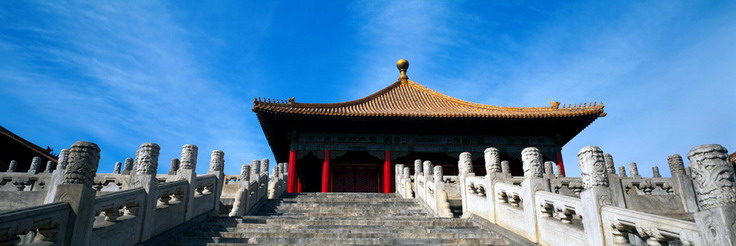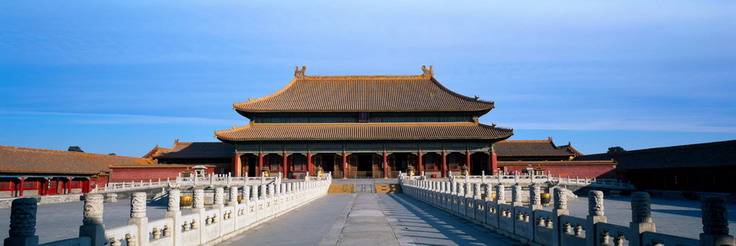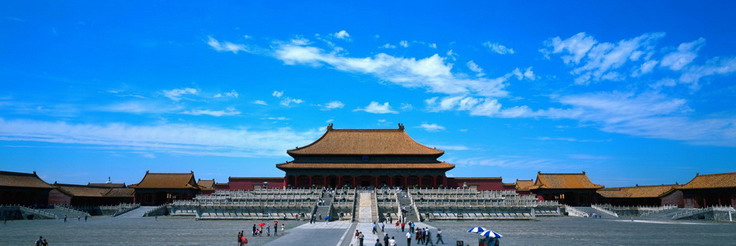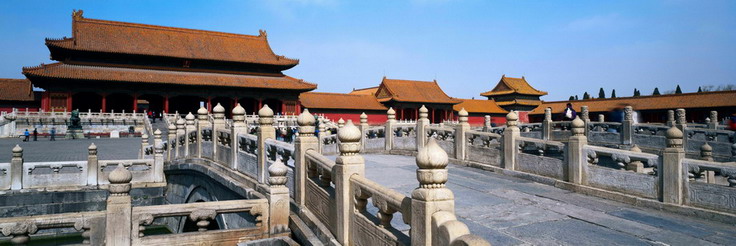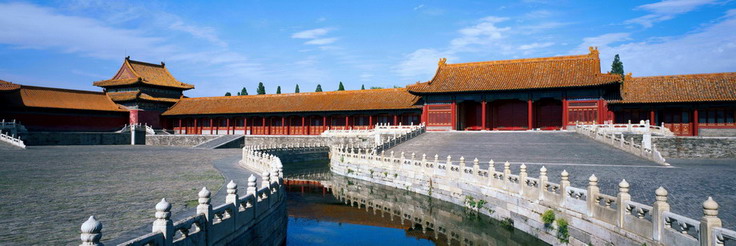What strikes one first in a bird's -eye view of Beijing proper is a vast tract of golden roofs flashing brilliantly in the sun with purple walls occasionally emerging amid them and a stretch of luxuriant tree leaves flanking on each side. That is the former Imperial Palace, popularly known as the Forbidden City, from which twenty-four emperors of the Ming and Qing Dynasties ruled China for some 500 years——from1420 to 1911. The Ming Emperor Yong Le, who usurped the throne from his nephew and made Beijing the capital, ordered its construction, on which approximately 10,000 artists and a million workmen toiled for 14 years from 1406 to 1420. At present, the Palace is an elaborate museum that presents the largest and most complete ensemble of traditional architecture complex and more than 900,000 pieces of court treasures in all dynasties in China.
Located in the center of Beijing, the entire palace area, rectangular in shape and 72 hectares in size, is surrounded by walls ten meters high and a moat 52 meters wide. At each corner of the wall stands a watchtower with a double-eave roof covered with yellow glazed tiles.
The main buildings, the six great halls, one following the other, are set facing south along the central north-south axis from the Meridian Gate, the south entrance, to Shenwumen, the great gate piercing in the north wall. On either side of the palace are many comparatively small buildings. Symmetrically in the northeastern section lie the six Eastern Palaces and in the northwestern section the six Western Palaces. The Palace area is divided into two parts: the Outer Court and the Inner Palace. The former consists of the first three main halls, where the emperor received his courtiers and conducted grand ceremonies, while the latter was the living quarters for the imperial residence. At the rear of the Inner Palace is the Imperial Garden where the emperor and his family sought recreation.
The main entrance to the Palace is
the Meridian Gate, which was so named because the emperor considered himself the "Son of the Heaven" and the Palace the center of the universe, hence the north-south axis as the Meridian line going right through the Palace. The gate is crowned with five towers, commonly known as
the Five-Phoenix Towers, which were installed with drums and bells. When the emperor went to the Temple of Heaven, bells were struck to mark this important occasion. When he went to the Ancestral Temple, it was the drums that were beaten to publicize the event.
Beyond the Meridian Gate unfolds a vast courtyard across which the Inner Golden Water River runs from east to west. The river is spanned by five bridges, which were supposed to be symbols of the five virtues preached by Confucius——benevolence, righteousness, rites, intelligence, and
fidelity.
At the north end of the courtyard is a three-tiered white marble terrace, seven meters above the ground, on which, one after another, stand three majestic halls;
the Hall of Supreme Harmony,
the Hall of Complete Harmony, and
the Hall of Preserving Harmony.
The Hall of Supreme Harmony, rectangular in shape, 27 meters in height, 2,300 square meters in area, is the grandest and most important hall in the Palace complex. It is also China's largest existing palace of wood structure and an outstanding example of brilliant color combinations. This hall used to be the throne hall for ceremonies which marked great occasions: the Winter Solstice, the Spring Festival, the emperor's birthday and enthronement, and the dispatch of generals to battles, etc. On such occasions there would be an imperial guard of honor standing in front of the Hall that extended all the way to the Meridian gate.
On the north face of the hall in the center of four coiled-golden dragon columns is the "Golden Throne", which was carved out of sandalwood. The throne rests on a two-meter-high platform with a screen behind it. In front of it, to the left and right, stand ornamental cranes, incense burners and other ornaments. The dragon columns entwined with golden dragons measure one meter in diameter. The throne itself, the platform and the screen are all carved with dragon designs. High above the throne is a color-painted coffered ceiling which changes in shape from square to octagonal to circular as it ascends layer upon layer. The utmost central vault is carved with the gilded design of a dragon toying with pearls. when the Emperor mounted the throne, gold bells and jade chimes sounded from the gallery, and clouds of incense rose from the bronze cranes and tortoises and tripods outside the hall on the terrace. The aura of majesty created by the imposing architecture and solemn ritual were designed to keep the subjects of the "Son of the Heaven" in awe and reverence.
The Hall of Complete Harmony is smaller and square with windows on all sides. Here the emperor rehearsed for ceremonies. It is followed by the Hall of Preserving Harmony in which banquets and imperial examinations were held.
Behind the Hall of Preserving Harmony lies a huge marble ramp with intertwining clouds and dragons carved in relief. The slab, about 6.5 meters long, 3 meters wide and 250 tons in weight, is placed between two flights of marble steps along which the emperor's sedan was carried up or down the terrace. It is the largest piece of stone carving in the Imperial Palace. Quarried in the mountains scores of kilometers southwest of Beijing, this gigantic stone was moved to the city by sliding it over a specially paved ice road in winter. To provide enough water to build the ice road, wells were sunk at very 500 meters along the way.
The three halls of the Inner Palace are replicas of the three halls in the front, but smaller in size. They are
the Palace of Heavenly Purity,
the Hall of Union, and
the Palace of Earthly Tranquility.
The Palace of Heavenly Purity was once the residence of the Ming emperors and the first two of the Qing emperors. Then the Qing Emperor Yong Zheng moved his residence to the Palace of Mental Cultivation and turned it into an audience hall to receive foreign envoys and handled the state affairs. The promotion and demotion of officials were also decided in this hall. After the emperor's death his coffin was placed here for a 49-day period of mourning.
The Palace of Union was the empress's throne room and the Hall of Earthly Tranquility, once a private living room for the empress, was partitioned. The west chamber served religious purposes and the east one was the bridal chamber where the newly married emperor and empress spent their first two nights after their wedding.
The Imperial Garden was laid out during the early Ming dynasty. Hundreds of pines and cypresses offer shade while various flowers give colors to the garden all year round and fill the air with their fragrance. In he center of the garden is the Hall of Imperial Peace, a Daoist temple, with a flat roof slightly sloping down to the four eaves. This type of roof was rare in ancient Chinese architecture. In he northeastern corner of the garden is a rock hill, known as the Hill of the Piled-up Wonders, which is topped with a pavilion. At the foot of the hill are two fountains which jet two columns of water high into the air. It is said that on the ninth night of the ninth month of the lunar calendar, the empress would mound the hill to enjoy the autumn scene. It is also believed that climbing to a high place on that day would keep people safe from contagious diseases.
The six Western Palaces were residences for empresses and concubines. They are kept in their original way for show. The six Eastern Palaces were the residences for them too. But now they serve as special museums: the Museum of Bronze, the Museum of Porcelain and the Museum of Arts and Crafts of the Ming and Qing dynasties. In the northeastern-most section of the Inner Palace are the Museum of Traditional Chinese Paintings and the Museum of Jewelry and Treasures where rare pieces of imperial collections are on display.
Now the Forbidden City is no longer forbidding, but inviting. A visit to the Palace Museum will enrich the visitors' knowledge of history, economy, politics, arts as well as architecture in ancient China.
